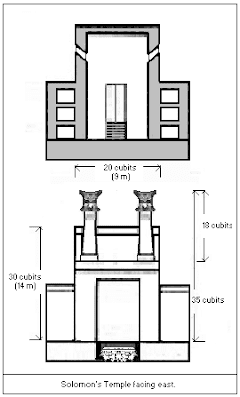The pillars in 1 Kings 7:15 are described as being "eighteen cubits high" whereas in 2 Chronicles 3:15 they are described as being "thirty and five cubits high". There is no contradiction because 1 Kings 7:15 describes the dimension of the pre-assembled pillars "apiece" whereas 2 Chronicles 3:15 describes the altitude of the finished product. 1 Kings 7:15-16 gives the following pre-assembly description of the pillars:
We can see that this is a pre-assembly description of the dimensions of each part because the height is given for each pillar "apiece" and the chapiters are described as< being made "to set upon" the tops of the pillars, meaning they have not been set there yet. In contrast, the description in 2 Chronicles 3:15 is of the finished product and the altitude of the pillars. It says:
This description is that of a finished product. The pillars are "before the house" and the chapiter on each of the pillars is described as being "on the top". In this finished product, the two pillars are described as being "thirty and five cubits high". This can be taken to mean the altitude of the pillars rather than their dimensions "apiece" (a word not found in the description of 2 Chronicles 3:15). The 18 cubit pillars were apparently erected on top of a base that was 17 cubits high. The following sketch of Solomon's temple shows that whereas the pillars were 18 cubits high "apiece", their altitude was altogether 35 cubits high (this sketch of the temple differs from other sketches that do not recognize the distinction between the dimension of the pre-assembled pillars and the altitude of the finished temple). Image from: Wikipedia: Solomon's Temple <http://en.wikipedia.org/wiki/Solomon's_Temple> |
|
|

